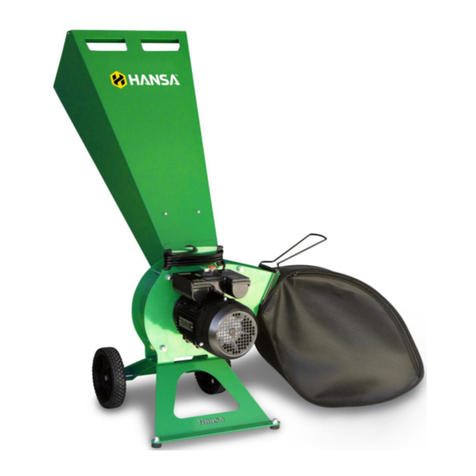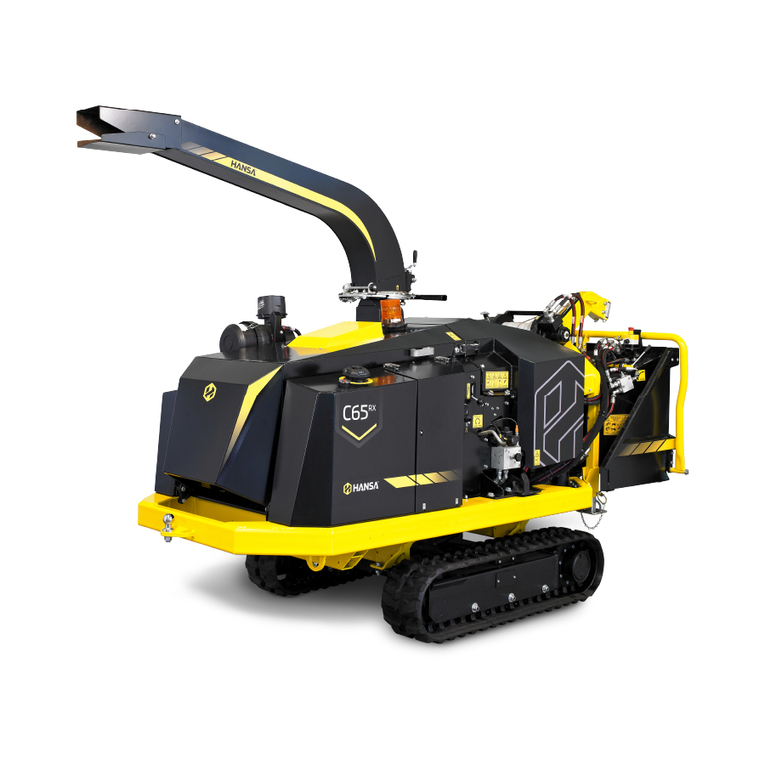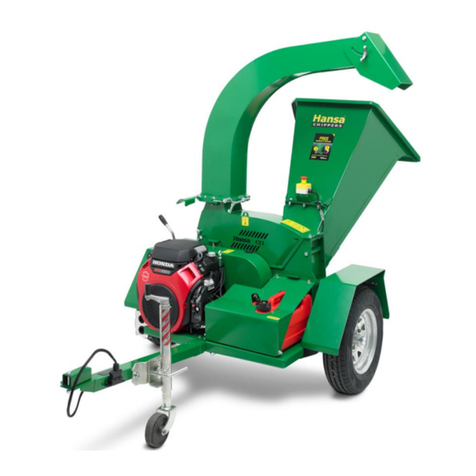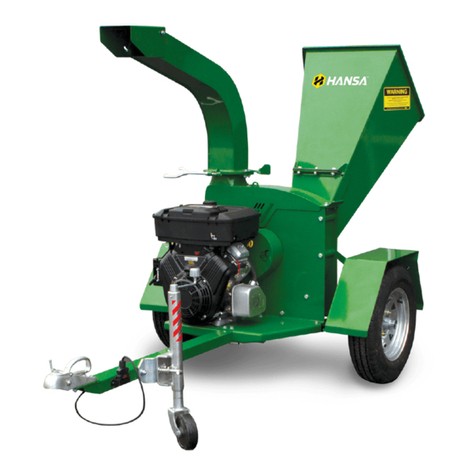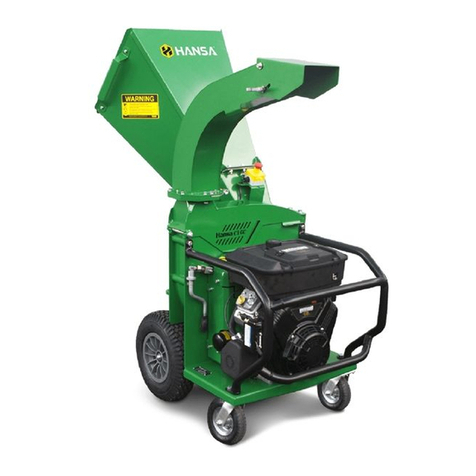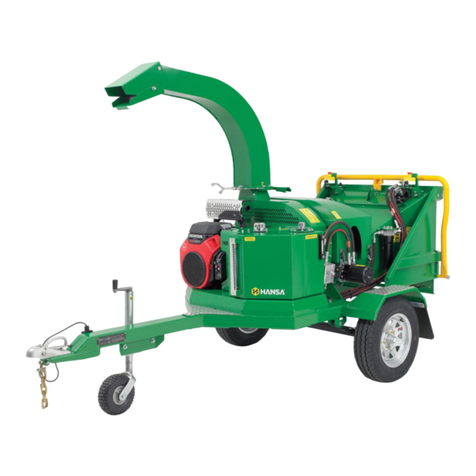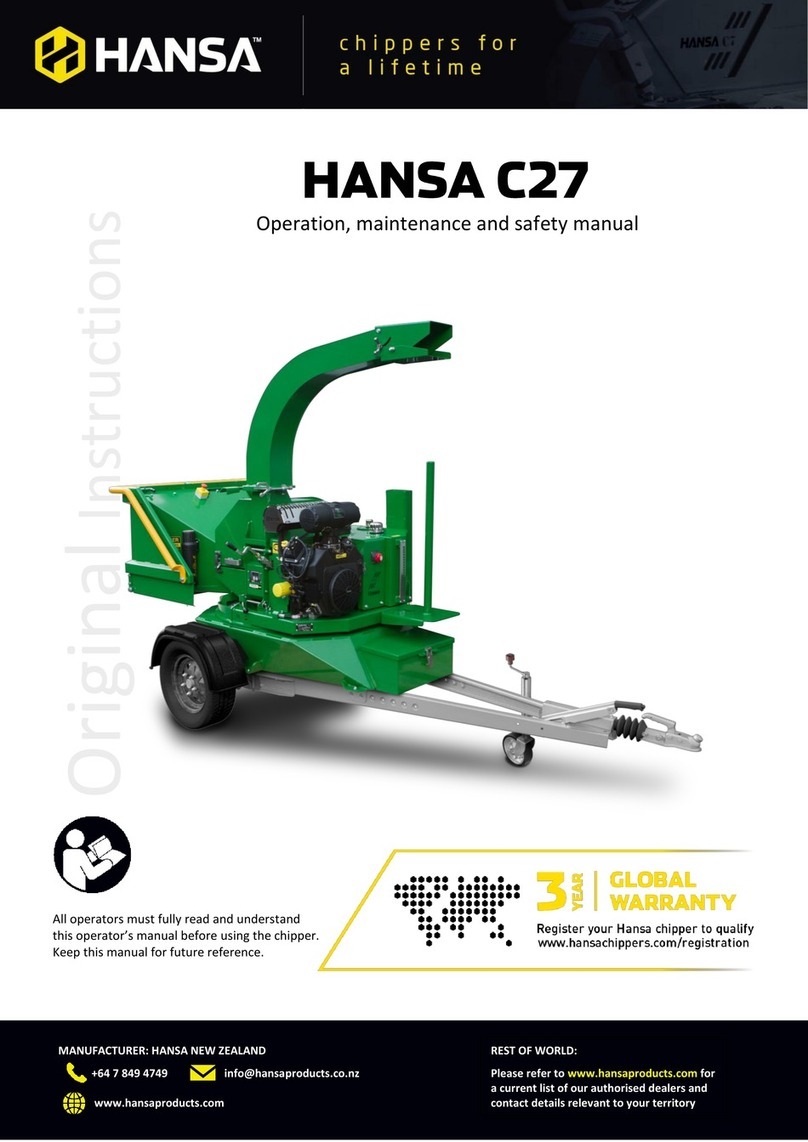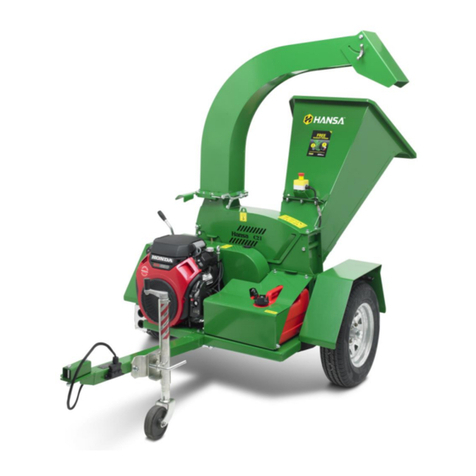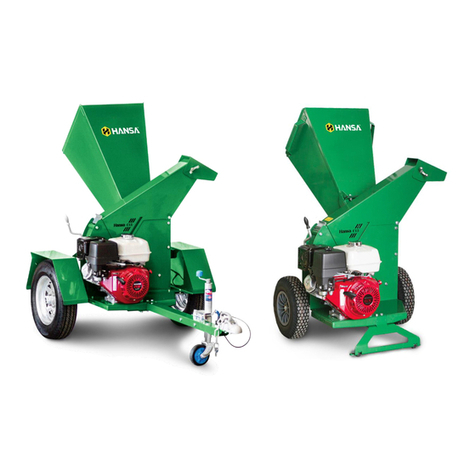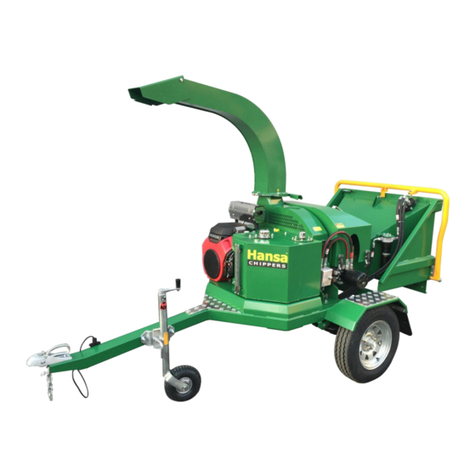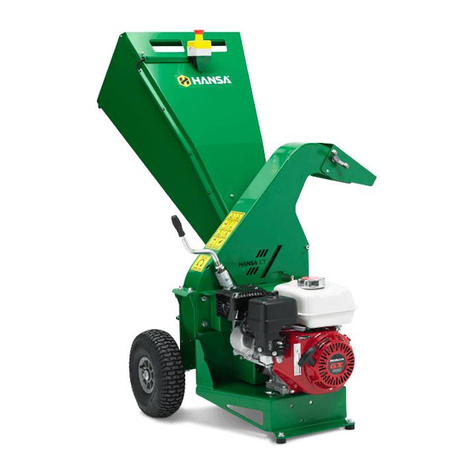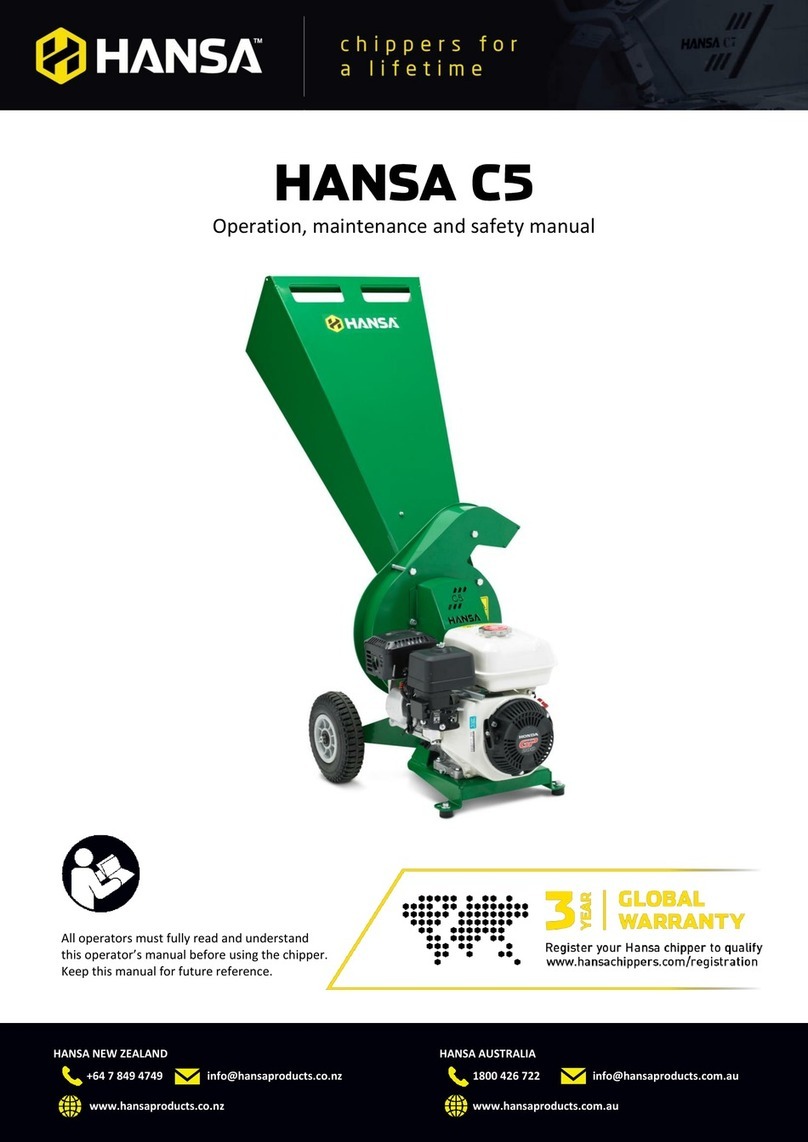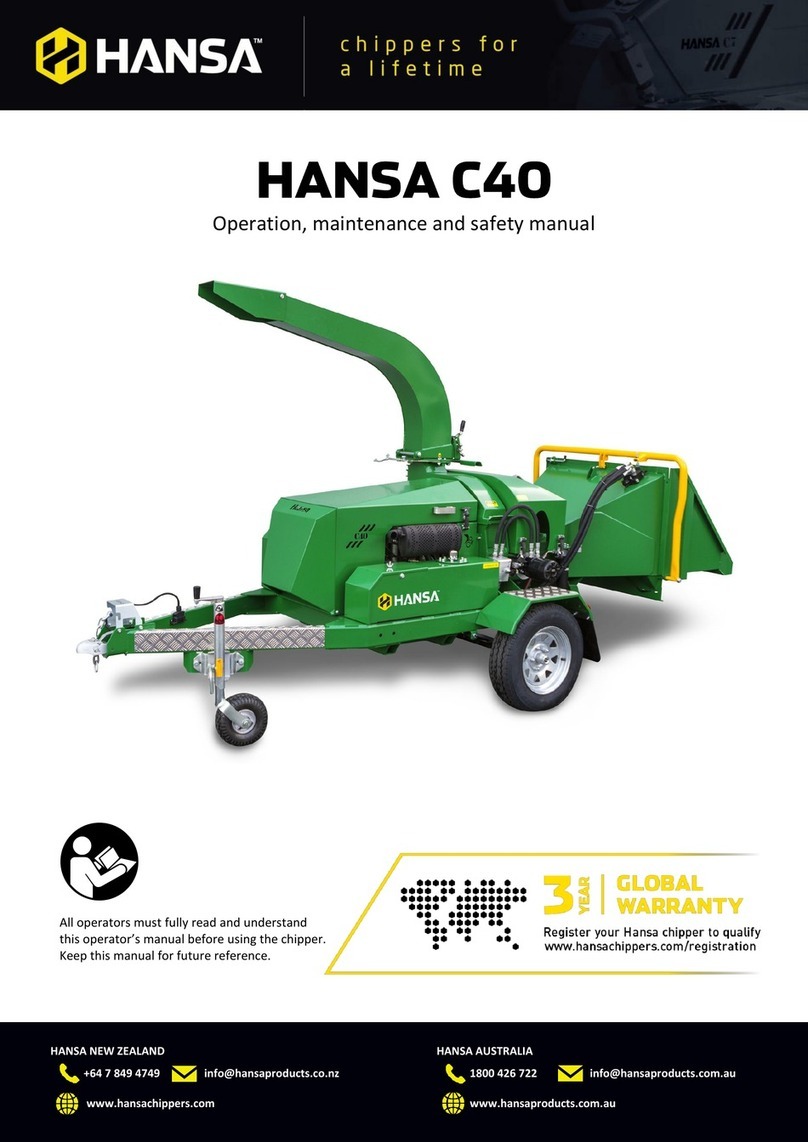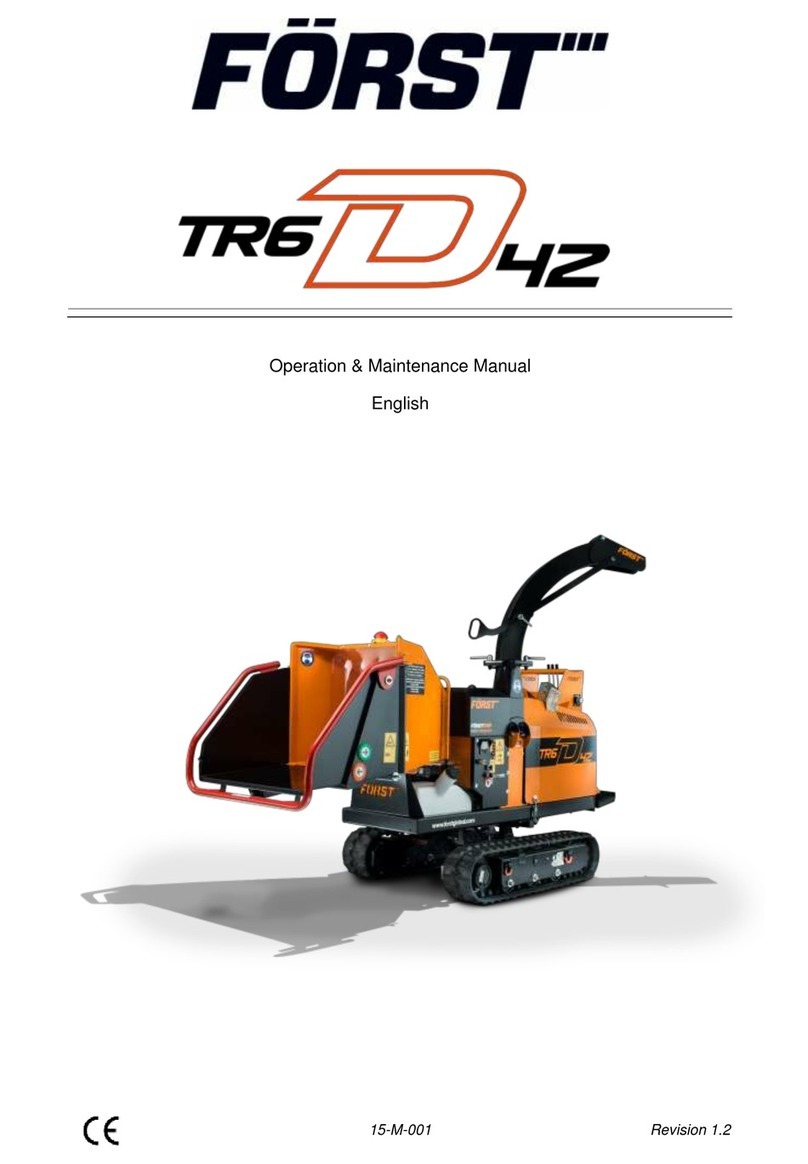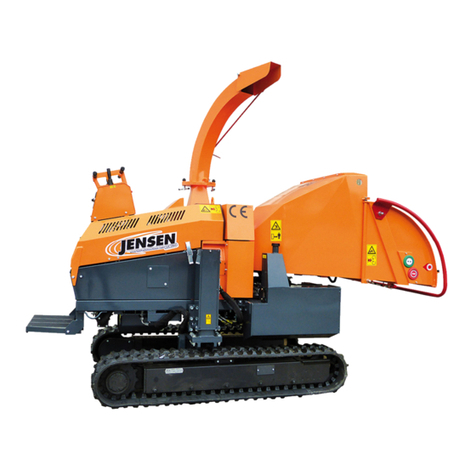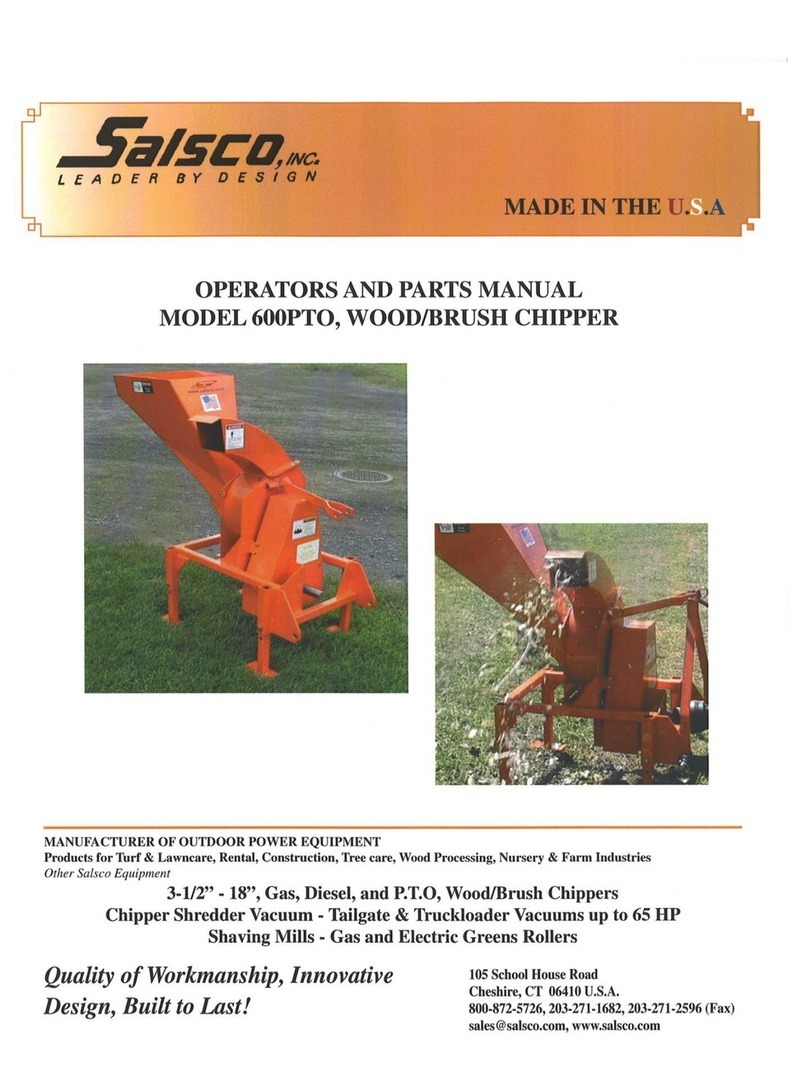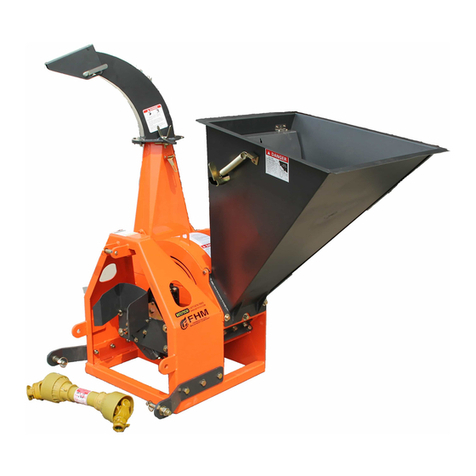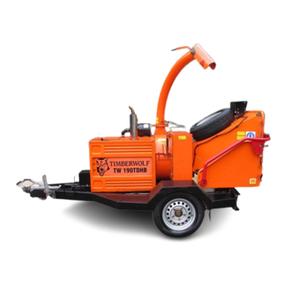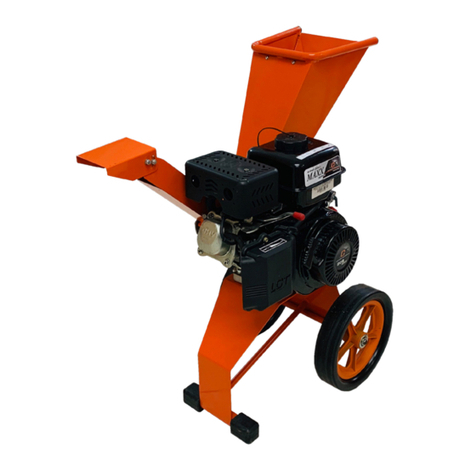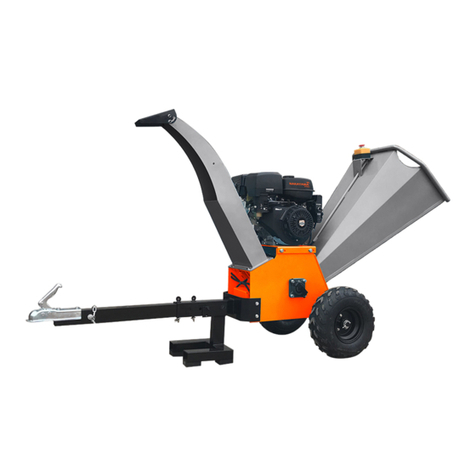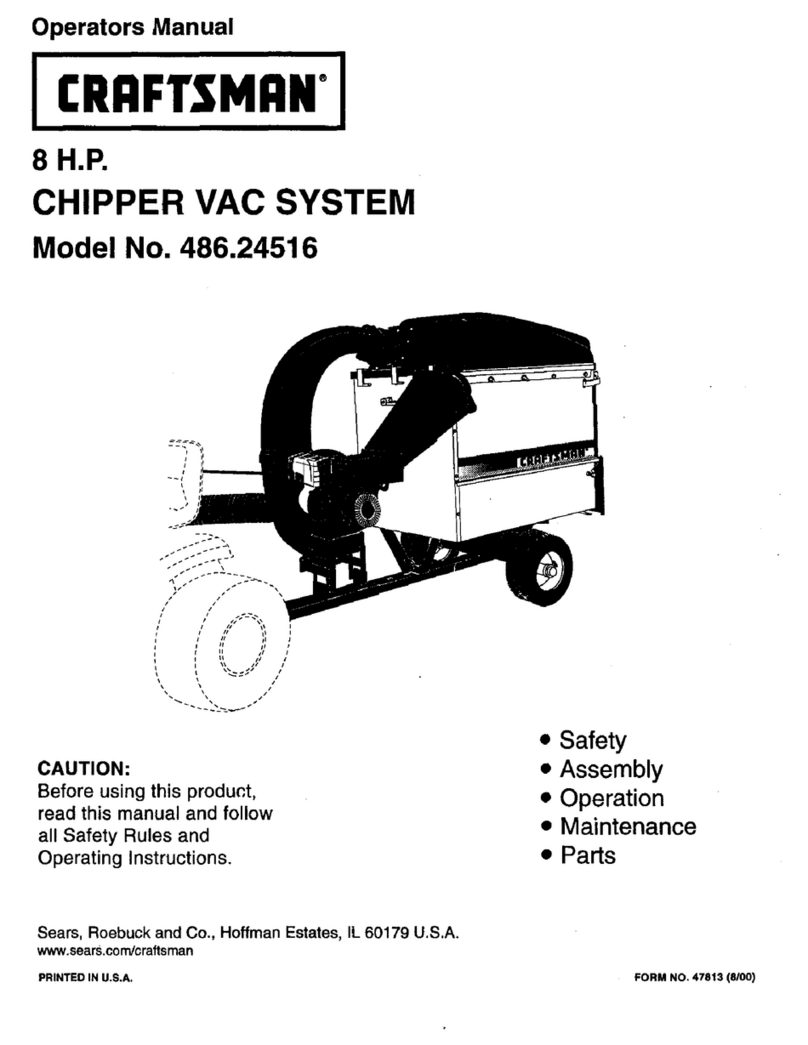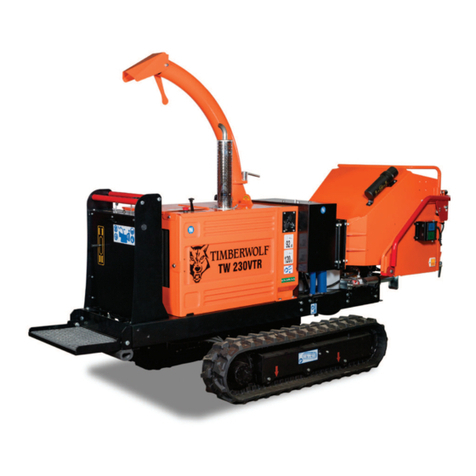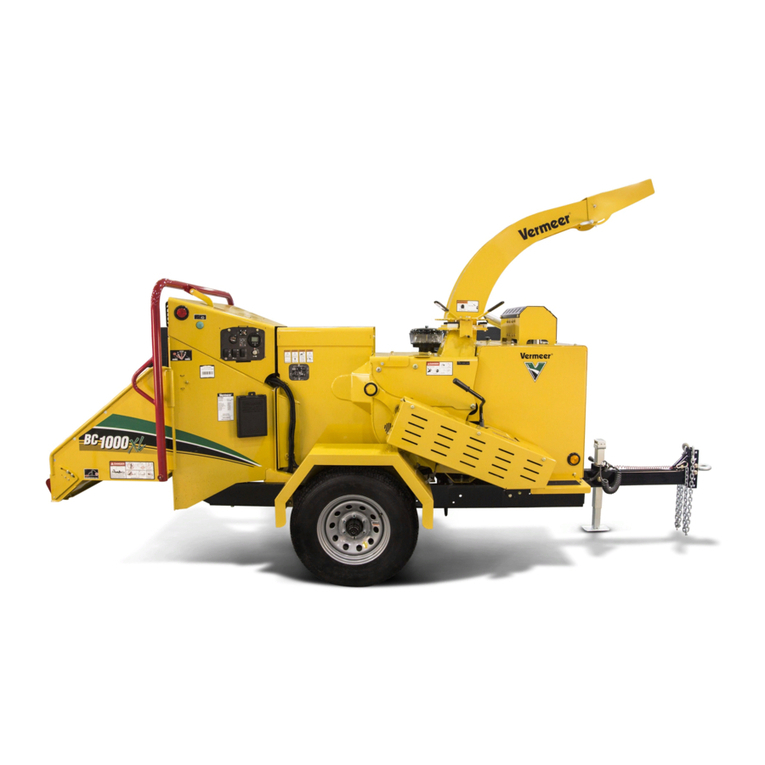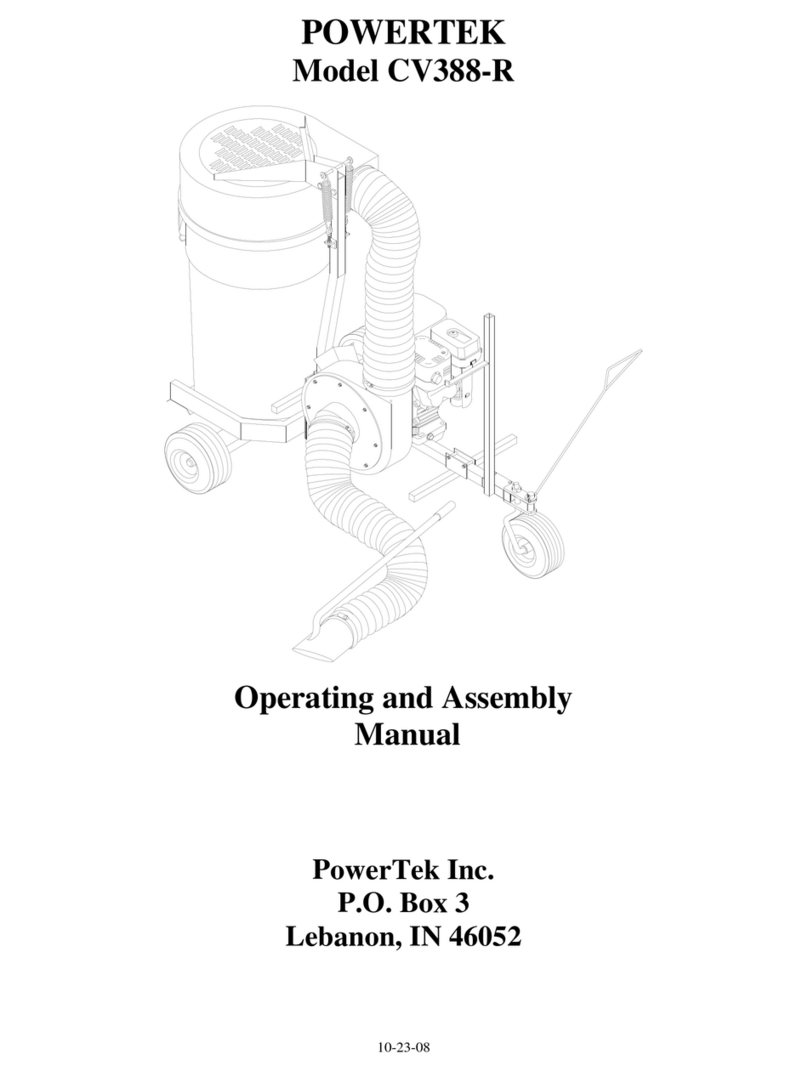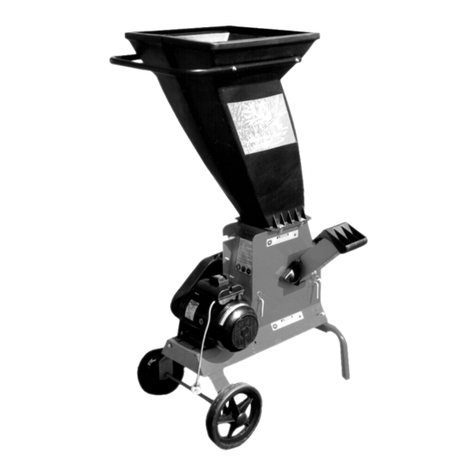Hansa C13 PTO User guide

HANSA NEW ZEALAND
+64 7 849 4749 info@hansaproducts.co.nz
www.hansaproducts.co.nz
HANSA AUSTRALIA
1800 426 722 info@hansaproducts.com.au
www.hansaproducts.com.au
Operation, maintenance and safety manual
All operators must fully read and understand
this operator’s manual before using the chipper.
Keep this manual for future reference.

Hansa C13/C21 PTO O&M Manual –OM-008 Revision E 13/06/2019
© Hansa Chippers 2019
TABLE OF CONTENTS
WHAT CAN MY HANSA CHIPPER PROCESS?..................................................................................................................................1
INTENDED USES OF THE CHIPPER ...............................................................................................................................................................1
RECEIVING YOUR HANSA CHIPPER ...............................................................................................................................................1
CHIPPER COMPONENTS (C13 PTO) ..........................................................................................................................................................1
CHIPPER COMPONENTS (C21 PTO) ..........................................................................................................................................................2
Parts supplied for assembly .......................................................................................................................................................... 2
ASSEMBLING THE CHIPPER........................................................................................................................................................... 3
FIT THE OUTLET CHUTE (C13 PTO) ........................................................................................................................................................... 3
FIT THE OUTLET CHUTE (C21 PTO) ........................................................................................................................................................... 4
FIT THE INLET CHUTE............................................................................................................................................................................... 4
PREPARE PTO DRIVE SHAFT ..................................................................................................................................................................... 5
SAFETY .........................................................................................................................................................................................5
OPERATOR COMPETENCY.........................................................................................................................................................................5
IDENTIFYING HAZARDS AND RISKS ..............................................................................................................................................................6
OPERATION..................................................................................................................................................................................6
SAFE SETUP PROCEDURE..........................................................................................................................................................................7
SAFE OPERATING PROCEDURE...................................................................................................................................................................7
STARTING PROCEDURE ............................................................................................................................................................................9
SHUTDOWN PROCEDURE .........................................................................................................................................................................9
STORAGE......................................................................................................................................................................................9
TROUBLESHOOTING.....................................................................................................................................................................9
WHAT TO DO IF:.................................................................................................................................................................................... 9
MAINTENANCE........................................................................................................................................................................... 10
KNIFE RE-SHARPENING AND KNIFE REPLACEMENT .......................................................................................................................................11
ANVIL ADJUSTMENT ............................................................................................................................................................................. 13
BELT TENSION .....................................................................................................................................................................................13
BELT REPLACEMENT.............................................................................................................................................................................. 14
BOLT TORQUE .....................................................................................................................................................................................15
SPECIFICATIONS ......................................................................................................................................................................... 15
DECALS....................................................................................................................................................................................... 16
HANSA GLOBAL INDUSTRIAL LIMITED WARRANTY..................................................................................................................... 18
COMMISSIONING CHECKLIST AND REGISTRATION ..................................................................................................................... 20

Hansa C13/C21 PTO O&M Manual –OM-008 Revision E 13/06/2019
© Hansa Chippers 2019
1
What can my Hansa chipper process?
Intended uses of the chipper
The Hansa C13/C21 PTO chipper is built to process organic material including wooden branches not exceeding 90 mm / 130 mm
diameter respectively. It is designed to be used on a regular basis to maintain large gardens, lifestyle blocks, acreages, along with
use by semi commercial garden maintenance contactors. Do NOT use the chipper for any other purpose.
Organic wastes include:
Prunings, stalks, roots, vegetable matter, hay, grass, bark
Dry manure
Branches
Palm fronds
Dead and hard timbers (Note: these will dull the knives faster)
Paper or cardboard
Do NOT process:
Flax, root balls
Soil, bones, sand, grit, stones, metal
If you have any questions, contact your authorised dealer.
Do NOT exceed 90 mm (C13 PTO) / 130 mm (C21 PTO) branch diameter
Receiving your Hansa chipper
Chipper components (C13 PTO)
C13 PTO
C21 PTO

Hansa C13/C21 PTO O&M Manual –OM-008 Revision E 13/06/2019
© Hansa Chippers 2019
2
Chipper components (C21 PTO)
Tools required for assembly (not supplied):
•16 mm spanner - to fit the inlet and outlet chute
•17 mm spanner - to fit the inlet and outlet chute
•Two 24 mm spanners - to fit the fixed inlet chute on the C13
Parts supplied for assembly
All fasteners included to fix inlet chute and outlet chute
onto the chipper
Inlet chute
Fixed outlet chute (if you have purchased a fixed outlet
chute C13 model)

Hansa C13/C21 PTO O&M Manual –OM-008 Revision E 13/06/2019
© Hansa Chippers 2019
3
Swivel outlet chute (if you have purchased a swivel
outlet chute C13 model or a C21)
Chipper body (C13 PTO shown in the image with a C13
outlet attached)
Assembling the chipper
When you receive your Hansa brush chipper, the inlet and outlet chute may not be assembled on the chipper.
All the fasteners (bolts, nuts and washers) are attached to their respective components.
Fit the outlet chute (C13 PTO)
Slide the outlet chute over the
black cutting rotor onto the chipper
body; the open side of the chute is
facing the engagement handle. Fix
the outlet chute to the chipper
body by tightening the bolts using a
16 mm and 17 mm spanner.
Tighten the two bolts and the base
of the outlet chute to hold the
outlet chute shut. Ensure the spring
washer is situated between the bolt
head and the heavy washer.
1
2

Hansa C13/C21 PTO O&M Manual –OM-008 Revision E 13/06/2019
© Hansa Chippers 2019
4
Fit the outlet chute (C21 PTO)
Lightly grease the flange on the
chipper body.
Slide the outlet chute onto the
greased flange of the chipper body,
ensuring that the locking hinge is
open.
Close the locking hinge and fasten
the two m6 bolts, spring washers,
and washers to the locking pin on
each side of the outlet using a 10
mm spanner. Ensure the spring
washer is between the bolt head
and washer.
Tighten the outlet chute locking
handle to secure the outlet chute to
the chipper body.
Note: The outlet chute locking
handle will be in the
documentation package.
Fit the inlet chute
Fix the inlet chute - place the inlet
chute onto the chipper body with
the black rubber flap sandwiched in
between and ensure all three holes
line up. Tighten the nuts, washers,
and bolts using a 16 mm and 17 mm
spanner. Ensure that the washer is
touching the bolt head.
1
2
3
3
Locking
hinge
Outlet
chute
locking
handle

Hansa C13/C21 PTO O&M Manual –OM-008 Revision E 13/06/2019
© Hansa Chippers 2019
5
Safety
Preventing accidents is the responsibility of every equipment operator. The operator is responsible for any accidents or hazards
occurring to people or their property. Ensure every operator is familiar with the safe operation procedures and controls of the
machine, how to identify hazards, and the steps required to avoid injury while handling and operating the chipper. Relevant
information is contained in this manual.
Do NOT modify the design of the chipper.
Operator competency
Ensure that every person operating the chipper understands and follows the safe operating and maintenance procedures
as detailed in this manual.
Do NOT allow persons below the age of 18 to operate the chipper. Additionally, local regulations may restrict the age of
the operator.
Do NOT allow persons with reduced physical, sensory or mental capabilities, or lack of experience and knowledge to
operate the machine.
Line up holes and insert the bolts,
washers and nuts, ensuring the big
washer is touching the bolt head.
Prepare PTO drive shaft
When attaching the PTO model to a tractor for the first time, it may be necessary to shorten the length of the supplied PTO
drive shaft. To shorten the shaft, proceed as follows:
Attach the chipper to the tractor via the three-point linkage and calculate the required shaft length.
Separate the two halves of the shaft and remove equal lengths of both the shaft and the outer sleeve to achieve
the required length. Ensure that the length of the shaft protruding from the sleeve remains the same as it was
on the uncut shaft.
Remove burrs from the shaft ends, grease and reassemble.
Note: Follow the PTO drive shaft manufacturer’s instructions for installation and use.
4
1
2
3

Hansa C13/C21 PTO O&M Manual –OM-008 Revision E 13/06/2019
© Hansa Chippers 2019
6
Identifying hazards and risks
Identify hazards and risks, and take preventative steps to avoid accidents and minimise risk. Possible hazards include, but are not
limited to, moving parts, thrown objects, weight of chipper and components, and the operating environment.
Below is a list of hazards and actions required to prevent injury:
Hazard
Risk
Corrective action
Dust
Injury or irritation of the
eyes
Respiratory irritation
Wear safety glasses
Process freshly cut materials and/or wear a dust mask
Belt Drive
Skin pinching and/or
abrasions
Ensure that the belt guard is in place, and keep away from
the belt
Cutting rotor and knives
Pinching, crushing, cutting,
severing
Keep your face and body out of the inlet chute
Do NOT extend hands/arms past the rubber flap
Use a stick to push materials into the inlet chute
Do NOT push the stick beyond the rubber flap
Sound
Damage to hearing
Always wear hearing protection when operating the
machinery
Discharge material
Eye injury, minor cuts
Always wear safety glasses when operating the machinery
Do NOT put any body part in front of the outlet
chute
Do NOT face the machinery in a place where the
outlet chute is directed on a hard surface
Feeding material
Cuts and scrapes
Wear safety gloves
Wear tight fitting long sleeves and pants to cover bare skin
when operating the machinery
Weight of the chipper
Straining, crushing
Place the machinery on firm level ground while operating
and while the chipper is being mounted to the three-point
linkage.
Operation
The chipper is self-feeding and has a large inlet opening. It can process:
•Prunings, stalks, vines, leaves, roots and vegetable matter, paper and cardboard
•Freshly cut material is better to process than dry
•Maximum branch diameter capacity for the C13 PTO and C21 PTO is 90mm and 130mm respectively
It is helpful, (but not required) to keep a wooden stick handy, approx. 80 mm diameter x 600 mm long for:
•Pushing in short, brushy and very leafy materials
•Keeping the inlet chute clear
C13 PTO
C21 PTO

Hansa C13/C21 PTO O&M Manual –OM-008 Revision E 13/06/2019
© Hansa Chippers 2019
7
Safe setup procedure
Before you start:
Ensure the chipper and tractor are positioned in an open area and on firm level ground
Ensure that the outlet chute is discharged onto soft ground (e.g. grass)
Do NOT allow the outlet chute to discharge chip onto hard surfaces (such as a paved or gravel surface)
Ejected material can rebound and cause injury
Keep children, pets and spectators clear of the work area at all times
Do NOT operate the chipper where there is a hazard to onlookers
Do NOT allow any person under the age of 18 to operate the chipper
Check:
That all screws, nuts, bolts, and other fasteners are properly secured
Check details on general chipper maintenance in this manual
That the all chipper components are in place and in good condition.
That the inlet chute and housing are clear of any leftover material
That the drive shaft is securely attached to the splined shafts on the chipper and the tractor, and that the safety
chains are attached.
That all labels are in good condition and easily legible
Replace damaged or unreadable labels
View photos of labels in the ‘Decals’ section
Safe operating procedure
Wear safety equipment: Safety glasses and hearing protection must
be worn at all times
Wear work gloves: The wearing of work gloves is optional but highly
recommended - ensure that the gloves fit tightly
Tie long hair up
Long hair could be pulled into chipper
Wear clothes that sit tightly
Avoid scarves and any items that can get caught in the chipper
Keep your face and body away from the inlet chute
Stand clear of the discharge cone, even when no material is being fed into the machine
Before starting the chipper, ensure that the inlet chute and housing are clear of any leftover material
Place the chipper on even ground and direct outlet chute on soft ground
Ensure the tractor exhaust is pointing away from the working area and downwind from the operator and onlookers
Keep proper balance and footing at all times and stand at the same level as the chipper
Do NOT overreach
Do NOT run near the machine
Operate the chipper with a PTO speed of 540 RPM
Feed only freshly cut material into the chipper
Do NOT feed in materials covered in gravel, stones and dirt as this can rebound, injure the operator and damage
the machinery
Prune to a size that suits the chipper’s capabilities
Pre-cut side branches
oThe branch will ‘self-feed’ more efficiently
Feed limbs and branches through butt end first, leaving the bushy head on
This helps guide the limb down the inlet chute
It reduces spinning and the occurrence of ejection of small pieces back up the inlet chute
Hold larger branches back and feed the chipper with care until you are familiar with its capacity
The engine will slow down or stall if the branch is too large
Feed longer pieces together with short stubby pieces
Feed soft materials intermittently with branches
The wood chips tend to clean out any soft residue left in the chipper
The chipper can clog up with soft, wet or fibrous materials
Keep the outlet free of blockage
DO:

Hansa C13/C21 PTO O&M Manual –OM-008 Revision E 13/06/2019
© Hansa Chippers 2019
8
oIf blockage occurs, turn the engine off, wait for rotor to stop spinning, then disconnect the PTO drive shaft. Open
the outlet chute and remove material until the outlet chute is clear
As the discharge material piles up
Move the chipper to direct the outlet chute away from the pile, or move the processed material
to avoid blocking
Turn off the tractor engine whenever you leave the work area
Run the chipper in an enclosed area
Exhaust fumes contain carbon monoxide which is poisonous, colourless, odourless, and tasteless
Operate the chipper wearing loose clothing and untied long hair
Stand at a higher level than the base of the chipper when feeding material into it
Process old materials such as dried wooden branches
They get very hard and springy when dried out
They are more awkward to handle
The knives dull much quicker
Feed short, stubby pieces of wood into the chipper
They bounce and spin in the inlet chute
Feed short stubby pieces together with longer pieces
Feed branches that are too large
The chipper can easily stall
Put soil, sand, grit, stones, glass, pieces of metal or other foreign objects into the chipper
This will damage the sharp edge of the cutting knives and can rebound and injure the operator
Put root balls and dead wood into the chipper
This dulls the knives quickly
Overload the chipper
If the cutting rotor is slowing down, feed the material in slower
Allow processed material to build up in the discharge area as this can
Prevent proper discharge
Result in kickback of material through the feed opening
Transport the chipper while the tractor PTO drive shaft is running
Operate the chipper with a PTO output speed greater than 650 RPM
Exceeding 650 rpm will cause chipper damage which could lead to injury
Operate the chipper with blunt knives
This causes excessive vibration which may result in damage to the chipper
Remove any guards on the chipper unless the engine is turned off, the PTO drive shaft is disconnected, and the cutting
rotor has come to a complete standstill
Touch any guards or stick hands between guards while the chipper is running
Put hands or any other part of the body or clothing:
Inside the feed chute past the rubber flap
Inside or near the opening of the discharge chute
Near any moving part
DO NOT:

Hansa C13/C21 PTO O&M Manual –OM-008 Revision E 13/06/2019
© Hansa Chippers 2019
9
Starting procedure
Before proceeding, ensure the ‘safe setup procedure’ has been followed on page 6 of this manual.
Ensure the chipper is securely attached via the three-
point linkage to the tractor. Ensure the drive shaft is
attached to the splined shafts on the chipper and the
tractor, and ensure that the guard chains are attached.
With the chipper placed firmly on the ground, parking brakes applied and the tractor idling; slowly engage the PTO
drive.
Increase the engine revs gradually to achieve a PTO speed of 540 rpm.
WARNING! Do NOT exceed PTO speed of 650 rpm. Exceeding 650 rpm will cause chipper damage which could lead
to injury. Ensure the chipper is firmly on the ground during operation.
Storage
Store the chipper out of the reach of children
Store the chipper out of the rain
Water can rust the steel body of the chipper
Troubleshooting
What to do if:
The chipper slows down and stalls
•The chipper is clogged up
Turn the engine off, disconnect the PTO drive shaft, ensure rotor has completely stopped, remove debris,
then close and lock the outlet chute
•The chipper can’t process the amount of material fed into it
Feed the material in slower
Shutdown procedure
Return the tractors throttle to the idle position.
Disengage the PTO shaft.
1
2
3
1
2

Hansa C13/C21 PTO O&M Manual –OM-008 Revision E 13/06/2019
© Hansa Chippers 2019
10
Reduce material volume
Discharge slows down
•The chipper is clogged up
Turn the engine off, disconnect the PTO drive shaft, ensure rotor has completely stopped, remove debris,
then close and lock the outlet chute
The chipper will not self-feed
•The knives and/or anvil might be blunt
Inspect and sharpen or replace knives and/or anvil as required. Ensure correct clearances between
knives and anvil
The material is ejected in long strips
•The knives and/or anvil might be blunt
Inspect and sharpen or replace knives and/or anvil as required. Ensure correct clearances between
knives and anvil
The chipper is clogged
Turn the engine off, disconnect the PTO drive shaft, ensure rotor has completely stopped, remove
debris, then close and lock the outlet chute
The chipper starts making unusual noise, the cutting rotor strikes a foreign object or the chipper starts to vibrate
Turn the engine off, disconnect the PTO drive shaft, and ensure rotor has completely stopped, then
inspect for damage
Replace or repair any damaged parts
Check for and tighten any loose parts
Do NOT attempt to repair the chipper unless you are competent to do so
Maintenance
Maintain the chipper with care and keep it clean at all times.
To service or inspect the equipment, or to change an accessory, you must:
✓Switch the tractor engine off
✓Wait until the cutting rotor and engine are at a complete standstill before opening the cutting rotor housing
✓Disconnect the PTO drive shaft from the tractor
Initially after 2 working hours:
✓Check for any loose nuts and bolts
✓Check belt tension (refer to belt tension section)
The belts will stretch when they are new
✓Grease the two rotor bearings (one at the front and one at the back of the housing) and the two PTO input shaft bearings
One or two pumps are sufficient
Be careful not to over grease
The bearings are already greased when the equipment is new
Use bearing grease or all-purpose grease
Every 20 working hours:
✓Check for any loose nuts and bolts
✓Check belt tension (refer to belt tension section)
✓Grease four bearings as above, be careful not to over grease
✓Check sharpness of knives
✓Check condition of guarding (belt guard, shaft guards, PIC guard and outlet chute)
A damaged guard must be replaced by an identical or equivalent guard immediately
It is recommended to contact Hansa for a replacement guard
WARNING! Do NOT open the housing unless the engine and cutting rotor have completely stopped.
WARNING! Prior to starting any maintenance tasks on the PTO driven chipper, ensure the tractor is parked on a flat, level
surface with the park brakes applied, engine stopped, chipper placed firmly on the ground, and the PTO drive shaft
removed.

Hansa C13/C21 PTO O&M Manual –OM-008 Revision E 13/06/2019
© Hansa Chippers 2019
11
Knife re-sharpening and knife replacement
How do I know that the knives need re-sharpening?
Chipper loses its self-feeding action with blunt knives
Material has to be pushed in
Material comes out in long strips
Blunt knives will cause excessive vibration
Blunt knives result in damage to the chipper
How to re-sharpen the knives:
If you don’t have a surface grinder or are unsure how to re-sharpen the knives, contact a professional saw doctor or Hansa to
arrange re-sharpening.
Tools and materials required for re-sharpening (approx. 40 mins):
•13 mm ring spanner (17mm for the C21 PTO)
•A stick magnet (optional)
•Surface grinder
•Coolant
Remove the knives for sharpening
Open the outlet chute, rotate the cutting rotor to gain access to the knives, then engage the belt drive to stop
the cutting rotor from rotating.
Use a 13 mm (or 17mm for C21 PTO) ring spanner to remove the knives from the
rotor. There are five bolts that you must remove to do so.
Be careful not to drop the nuts, bolts or knives into the chipper
A stick magnet can be used to retrieve them if this does occur
Measure the width of the knife and check that it will be at least 46 mm after
sharpening.
If the knives will be shorter than 46 mm, then the knives should be replaced.
Please contact your nearest Hansa dealer.
WARNING! Do NOT operate your chipper with blunt knives.
WARNING! Be careful when working around the sharp knives. Be aware that even though the machine is uncoupled,
the rotor can still move.
1
2
3
MIN 46 mm

Hansa C13/C21 PTO O&M Manual –OM-008 Revision E 13/06/2019
© Hansa Chippers 2019
12
Sharpen the knives
Sharpen the knives on a surface grinder. A cutting angle of 36 ° is critical for the
performance of the chipper. Make sure plenty of coolant is used when grinding to
avoid softening of the steel knives.
Reinstall the knives
Clean all mounting surfaces and remount
the knives in the reverse procedure.
Note: Be sure to replace the knives the
correct way around (as shown in the
diagram). Only tighten the clamping bolts
enough to hold the knives in place during
adjustment. Do not tighten them fully until
step 7.
Adjust the knives initially using the
adjustment bolts to protrude the edge of
the knife just past the edge of the knife
holding block.
After sharpening, the width of the knives
will have been reduced, therefore the gap
between the knives and anvil may require
adjustment. This gap is tapered out slightly
to allow for a small amount of movement in
the rotor as it bites into the wood.
If there is not enough clearance, the knife
edge may touch the anvil through
deflection when cutting heavy branches
and damage the sharp edge. Too much
clearance will allow small twigs and fibrous
materials to be dragged through without
being cut.
Adjust the knife in or out using the two
adjustment bolts to achieve the correct
clearance between the knife and anvil. The
clearance between the knife and anvil
should be approximately 1 mm on the
inside closest to the bearing and 3 mm on
4
5
6
7
36 °
Knife
Adjustment bolts
Locking nuts
Rotor disc
Knife holding block
Clamping bolts
Clamping plate
Knife holding
block
Knife
Side view: Cutting rotor

Hansa C13/C21 PTO O&M Manual –OM-008 Revision E 13/06/2019
© Hansa Chippers 2019
13
the outside closest to the edge of the
cutting rotor (refer to diagram for more
detail).
After the correct clearance is set, fully
tighten the M8 clamping bolts using a
torque wrench to 35 Nm (for the C21PTO,
tighten the M12 clamping bolts to 77 Nm)
and tighten the locking nuts on the
adjustment bolts.
Note: Before adjusting the knives, ensure
the gap between the holding block and the
anvil is 4 - 5 mm. If not, then the anvil can
be adjusted through the mounting slots.
Once the position has been set, tighten the
three M10 countersunk anvil bolts and
torque to 50 Nm, then make further
adjustments with the knives as described
above.
Turn the rotor slowly by hand to check that
it turns freely.
Close and secure the outlet chute.
Anvil adjustment
The anvil is reversible. When the edge is dull, it can be reversed. The anvil typically lasts for several hundred hours of operation.
When both edges are worn, the anvil can be sharpened or replaced. To access the anvil the inlet chute needs to be removed. With
the knives removed or set right back, the gap between the knife holding block and anvil should be 4 - 5 mm. The anvil can be
adjusted through the mounting slots. When this has been set, tighten the three M10 countersunk anvil bolts using a torque wrench
to 50 Nm and then make further adjustments with the knives as described above.
Turn the cutting rotor slowly by hand to check that it turns freely.
Belt tension
Correct belt tension is crucial for minimising belt wear and maximising
machine efficiency. To check the belt tension, the belt guard must first
be removed (see step 1 below). After the belt guard is removed, fully
engage the belt. There should be approximately 10 mm deflection in the
belt when pressing firmly on the belt (as per the image below). If
required, adjust belt tension.
WARNING! Every time the knife clamping bolts are torqued up to 35 Nm (C13 PTO m8 bolts) or 77 Nm (C21 PTO m10
bolts) and loosened off again, the life of the bolts is reduced. The knife clamping bolts must be replaced at most after
every six sharpens. Contact Hansa for replacement bolts (m8x35 bolts for a C13 PTO and m12x50 bolts for a C21 PTO
of grade 10.9 or higher). Use only genuine Hansa bolts.
8
Anvil
Cutting
rotor
Knife
1 mm
clearance
3 mm
clearance
Bearing
Edge of
rotor
Top view: knife and anvil set-up
Check for
deflection here

Hansa C13/C21 PTO O&M Manual –OM-008 Revision E 13/06/2019
© Hansa Chippers 2019
14
Belt replacement
If the belts in your chipper look similar to any of the following images or are clearly broken, then they need to be replaced.
The C13 PTO requires two B55 vee belts and the C21 requires three B60 vee belts. If the belts require replacement, follow the
‘adjusting belt tension’ procedure. After replacing the belts, check the tension after two hours of operation. The tension of a new
belt will quickly change as the belt initially wears into the pulley system.
Adjusting belt tension
Remove the PTO drive shaft from the chipper and remove the belt guard (three M8 cap screws, requiring a size 6
Allen key to remove)
Loosen the clamping and adjusting nuts (refer to diagram below) using a 17 mm spanner. Check the condition of
the belts. If they are in poor condition they will need to be replaced (see the ‘Belt replacement’ section on the
following page).
Adjust the position of the idler using the
adjusting nuts to achieve 10 mm of deflection
when the belts are pushed with the fingers.
Tighten both nuts to lock the idler in position.
Tighten the clamping nuts to secure the adjustor.
Refit the belt guard and PTO drive shaft.
1
2
3
4
5
Cracked underside of belt
Sidewall belt wear
Soft, swollen belt
Worn cover on back of belt
Split belt cover
Adjustor
Adjusting nuts
Clamping nuts

Hansa C13/C21 PTO O&M Manual –OM-008 Revision E 13/06/2019
© Hansa Chippers 2019
15
Bolt torque
Relative Strength Bolt Marking
4.6
8.8
Recommended Tightening Torque
Recommended Tightening Torque
Bolt size
Spanner size
lb ft
Nm
lb ft
Nm
M8
13 mm
6
8.5
16
22
M10
16 mm
12.5
17
32
44
M12
18 mm
22
30
57
77
M16
24 mm
54
73
140
190
M20
30 mm
105
143
274
372
Specifications
C13 PTO
C21 PTO
General
Length
1260 mm
1400
Width
930 mm
1060
Height
1540 mm
1950
Weight
177 kg
307 kg
Power supply
Horsepower range
17-45 HP tractor
20-55 HP tractor
Cutting System
Disc speed
1500 RPM
1500 RPM
Disc dimensions
560 x 12 mm
650 x 20 mm
Shaft diameter
31.75 mm
50 mm
Knives
2
2
Feed System
Chipping capacity
90 mm
130 mm
Feed type
Gravity fed, self-feeding
Gravity fed, self-feeding
Inlet chute opening
170 x 220 mm
200 x 285 mm
Discharge System
Discharge height
1060 mm
1800 mm
Outlet chute type
Fixed outlet with deflector (with
swivel chute option)
270⁰ swivel

Hansa C13/C21 PTO O&M Manual –OM-008 Revision E 13/06/2019
© Hansa Chippers 2019
16
Decals
Decal
Description
Location
General machine safety
and inlet chute
considerations
Side of inlet chute
PIC guard hazard and
nominal rotation
Top of PIC guard
Belt guard hazard
Rotor housing front, next to the belt guard
Bearing guard
entanglement
Next to bearing guards (x2 for C13 PTO)

Hansa C13/C21 PTO O&M Manual –OM-008 Revision E 13/06/2019
© Hansa Chippers 2019
17
Rotor and housing
safety (fixed chute C13
model only
Top face of outlet chute
Outlet chute and
deflector hazards
(C13PTO only)
Outlet deflector
Outlet chute safety
(Swivel chute models
only)
Outlet chute
PTO shaft and three-
point linkage safety
Housing front beside belt guard

Hansa C13/C21 PTO O&M Manual –OM-008 Revision E 13/06/2019
© Hansa Chippers 2019
18
HANSA global industrial limited warranty
For the purposes of this warranty document, “HANSA” means HANSA Products Limited and any of its international subsidiary
companies. Refer to contact details below for further information.
HANSA warrants each new HANSA chipper (“HANSA product”) free from defects in materials and workmanship under normal use
and routine servicing, for the warranty periods and subject to the limitations and exclusions detailed below.
HANSA offers a special extended warranty period (“Extended Warranty”) to new HANSA products purchased from an authorised
HANSA dealer. The Extended Warranty period is set out below. In order to take advantage of the Extended Warranty you must:
1. Register your HANSA product through the HANSA warranty registration process and identify your HANSA product by its
machine serial number. Registration must be completed with ten (10) days from the date of purchase. Your warranty
registration confirmation email is your identification for warranty service; and
2. Have your registered HANSA product maintained in accordance with the schedule contained in the relevant owner’s manual
supplied with the product by an authorised HANSA dealer for the applicable territory. In order to ensure the safe operation
of your HANSA product, we strongly recommend that you only use an authorised HANSA dealer for servicing. The cost of
routine or required maintenance and services is the responsibility of the purchaser. You must keep a record of all service and
maintenance history as proof of servicing history. HANSA may request such servicing history when assessing any future
warranty claim.
When making a claim for warrantable repairs under the Extended Warranty, your warranty registration must accompany the
HANSA product. If the warranty registration is lost or destroyed, proof of purchase documentation clearly recognising the machine
serial number shall be accepted for warranty purposes. Where neither is available and HANSA does not have any record of the
purchaser’s details the warranty period shall be calculated from the appropriate dealer wholesale sale date. Any claim under the
applicable Warranty must be made within the relevant warranty period specified below.
The Extended Warranty may be subject to cancellation if the above requirements are not satisfied.
The Extended Warranty is available to domestic (non-commercial) and commercial customers (excluding commercial customers in
the business of plant/equipment hire).
All HANSA products that have not complied with the Extended Warranty registration and maintenance requirements are entitled
to the “Non-Registered” warranty period set out below.
Any authorised HANSA dealer is further authorised to repair or replace any part which proves defective within the limits of the
Extended Warranty or Non-Registered Warranty (the “Warranties”) at no charge to the owner, covering parts and labour.
Consumable items such as but not limited to oils, grease, blades and belts shall be the responsibility of the owner. All defective
parts replaced under the Warranties become the property of HANSA.
You (as owner) are responsible for all shipping and transportation costs (including insurance) to and from an authorised HANSA
dealer for the product subject to a warranty claim.
Exclusions
The warranties shall NOT APPLY TO:
•Any damage which results from neglect of periodic maintenance specified by HANSA.
•Any damage which results from repair or maintenance operations by methods other than specified by HANSA.
•Any damage which results from misuse or use beyond the limitations of the intended use specified by HANSA in the
operation, maintenance and safety manual, such as overloading, including foreign objects such as stones, pieces of steel,
glass etc. being dropped into the running machine or use under abnormal conditions (in HANSA’s sole judgement).
•Any damage which results from use of non-genuine parts, lubricant or fluid not approved by HANSA.
•Any damage resulting from modification or installation in other products in a way not approved by HANSA which has any
influence on the function and/or performance of the products.
•Any damage which results from operation other than specified in the Owner’s Manual either intentionally or by error.
•Fading of painted surfaces, deterioration of plated surfaces, deterioration of rubber and plastics, including rusting due to
the passage of time.
•Normal phenomena such as noise, vibration or oil seepage which are considered by HANSA as not affecting the quality,
function or performance of the product.
•Any damage due to improper storage or transport.
•Consumable replacement items: Belts, cutting blades, anvil, serviceable bearings.
•Periodical maintenance items such as cleaning, inspection and adjustments.
•Any repair and/or adjustment performed by persons other than an authorised dealer, or damage resulting therefrom.
•Any repair and/or adjustment to correct improper or poor quality work previously performed.
This manual suits for next models
1
Table of contents
Other Hansa Chipper manuals


